Zotac Z68ITX-A-E Wifi Review - Mini-ITX meets Z68
by Ian Cutress on September 22, 2011 10:01 AM EST- Posted in
- Motherboards
- Mini ITX
- ZOTAC
- Z68
LAN Speed Test
LAN Speed Test is a freeware program designed for testing the network connection between two PCs on a home network. The speed of the transfer is limited by the lowest common denominator on the network, so if you have gigabit Ethernet capable computers but a 100 Mbit capable router, you are limited to 100 Mbit transfer. For this test, we use LAN Speed Test to transfer a 1000 MB file across a home network with a 1 Gbps lowest common speed to the same machine each time, in a read/write scenario, using CAT6 cable.
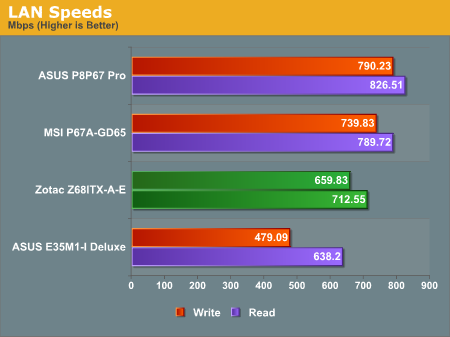
As I'm moving from 100 Mbps testing to 1 Gbps testing here, I only have a limited pool of results to look at. Unfortunately in this limited range, the Zotac doesn't fare too well with its Realtek solution.
USB Speed
For this benchmark, we run CrystalDiskMark to determine the ideal sequential read and write speeds for the USB port using our 64GB Patriot SuperSpeed USB 3.0 drive. Then we transfer a set size of files from the SSD to the USB drive, and monitor the time taken to transfer. The files transferred are a 1.52 GB set of 2867 files across 320 folders – 95% of these files are small typical website files, and the rest (90% of the size) are the videos used in the Sorenson Squeeze test.
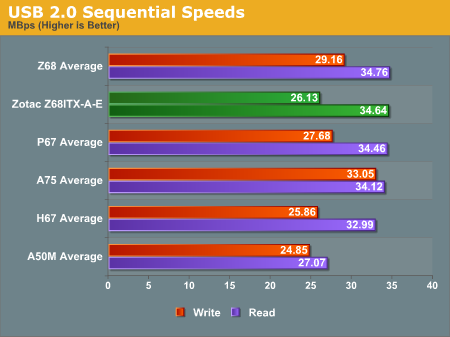
USB 2.0 from the PCH here does well in sequential reads, but doesn't perform too well in sequential writes.
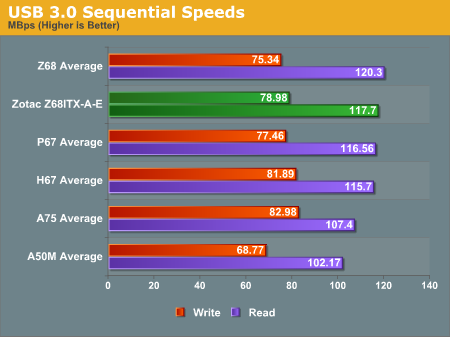
Zotac's VIA solution for USB 3.0 doesn't do too badly in our sequential testing.

Compared to other Z68, the real world performance of the Zotac board isn't breaking any records today.
SATA Testing
We also use CrystalDiskMark for SATA port testing. The operating system is installed on the Micron RealSSD C300, which is rated at 355 MB/s read and 215 MB/s write, and the sequential test is run at the 5 x 1000 MB level. This test probes the efficiency of the data delivery system between the chipset and the drive, or in the case of additional SATA ports provided by a third party controller, the efficiency between the controller, the chipset and the drive.
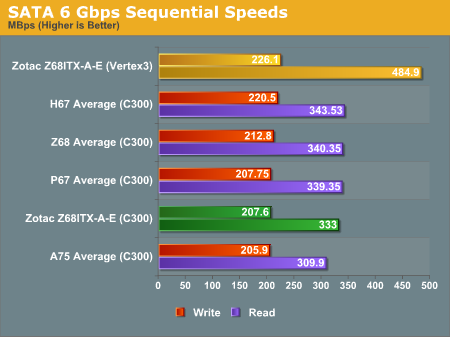
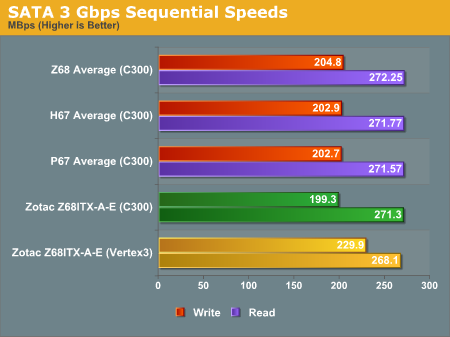
DPC Latency
Deferred Procedure Call latency is a way in which Windows handles interrupt servicing. In order to wait for a processor to acknowledge the request, the system will queue all interrupt requests by priority. Critical interrupts will be handled as soon as possible, whereas lesser priority requests, such as audio, will be further down the line. So if the audio device requires data, it will have to wait until the request is processed before the buffer is filled. If the device drivers of higher priority components in a system are poorly implemented, this can cause delays in request scheduling and process time, resulting in an empty audio buffer – this leads to characteristic audible pauses, pops and clicks. Having a bigger buffer and correctly implemented system drivers obviously helps in this regard. The DPC latency checker measures how much time is processing DPCs from driver invocation – the lower the value will result in better audio transfer at smaller buffer sizes. Results are measured in microseconds and taken as the peak latency while cycling through a series of short HD videos - under 500 microseconds usually gets the green light, but the lower the better.
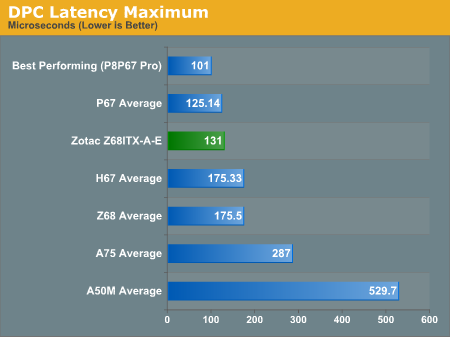
Compared to other Z68, the Zotac performs quite well in our DPC testing.










29 Comments
View All Comments
GeorgeH - Thursday, September 22, 2011 - link
This review mirrors my experiences with Zotac motherboards - awesome hardware on paper that's completely let down by abysmal BIOS and tweaking support.dlang1234 - Thursday, September 22, 2011 - link
Heat and noise...More interested in those, looks like an awesome HTPC. mini itx usually isn't targeted at a gamer, but Home Theaters or specific in car or other unique installations.
I'm more interested in how well it would work playing Blu-Rays, streaming media all at 1080p. Audio over HDMI? etc..
Anosh - Thursday, September 22, 2011 - link
There's a new version of the bios which seems to fix some of the issues mentioned (XMP, undervolting etc) and it would be great if you could take a look at what they tried to fix and what they actually managed to fix.I've had this board under consideration for a long time now since it's one of the few 1155 itx with both displayport and hdmi (and wifi) but I'm glad I didn't go for it since there are so many issues floating around (buzzing, faulty memory slots, doa, lacking bios, stops booting after x months etc) that I would've had to replace it not long after getting.
I've read retailers are dumping zotac inventory based on the horrible experiences customers have had with this product. Also there seems to be new revision under way.
I'm typing this on an iPoop so trying to find all the reference links to backup my claims would take forever but search a bit and you'll discover they're easy to find.
mayankleoboy1 - Thursday, September 22, 2011 - link
all the other boards are tested with c300 and this board is tested with vertex3, gibing higher numbers??IanCutress - Thursday, September 22, 2011 - link
We tested the board with both, and both results are given in the graphs.OCZ were kind enough to provide Vertex3s for Brendan and I to use in future reviews (Brendan does not have access to a C300), but we currently do not have enough Vertex3 results to warrant a graph using purely Vertex3 results So for the time being we're showing C300 results with an example of what happens with the Vertex3.
All the best,
Ian
Breathless - Thursday, September 22, 2011 - link
Why would you not have updated the bios prior to doing the review? The bios has been out for quite some time now...IanCutress - Thursday, September 22, 2011 - link
Simply put, a lot of people never update their BIOSes from the shipping version, so we have to test that. With the Intel spec issues, when the testing for this board was done, Zotac sent me the BIOS while it was still in beta phase, and I've been in contact with Zotac regarding the issues I was having with that beta release (the DIMM slot not working being a big issue). It seems to have been pushed into a full release since then (as of 9/9), despite my issues. As a result, I have updated the review to notify it is now a full BIOS release.Ian
Mr Perfect - Thursday, September 22, 2011 - link
Do you have any information on what caused the DIMM slot to fail? There is one guy on HardForums who, after having that problem on his own machine, then went on to test every board he had in stock at his shop. I'm not sure if it's something he was doing, or a fault with the design, but every one he tried had that issue.FATCamaro - Thursday, September 22, 2011 - link
You barely talked about stability. Reviews are useless without it to me. I'd rather look at the star rating on newegg to figure out whether i want the board or not. It's the single most important aspect, yet it doesn't even get lip service.Iketh - Thursday, September 22, 2011 - link
how could he comment on stability? if he didnt experience any and thus didn't comment on it, it's quite obvious that it ran fine... newegg's ratings are a bunch of boards from daily users, this is one board that was ran through benchmarks... so how the hell can you ask him to, at the minimum, reproduce newegg's results???